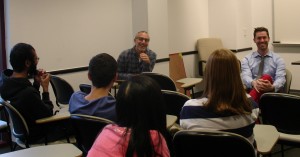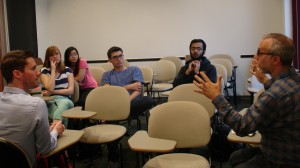About four years ago, Anthropology professor Jeffrey Fleisher says he received a wake up call when he read a student’s evaluation of his course Archaeology 205 (Introduction to Archaeology): “Professor Fleisher hates this class, not the students, but the material.” As a professor passionate about teaching and helping his students learn, Dr. Fleisher reflected and realized that it was time “to do something different.”
To spice up this course, he turned to technology. Instead of a usual lecture-style course, Fleisher flipped his class so that students worked on problem sets during class, which gave them the same understanding as lectures on the same material. Eventually, he hopes to create short videos to post on 0WL-space as supplemental explanations of topics. This teaching technique has proved to be more efficient and effective.
For instance, Fleisher used to spend an entire week each semester explaining the techniques archaeologists use to date artifacts and sites. Now, he has expedited this process: his students read some key texts, and then work with site data developed to test their understanding of how and when to use particular dating techniques. During the class period, they check in with Fleisher to tell him which item they are going to use and how they will apply it. According to Fleisher, students learn more quickly because “this trial and error forces them to find out how the technique works,” as well as its limitations. Not only is the time spent on this topic shortened, but the lessons students learn are also more memorable and thus more valuable!
Flipping a class is time consuming and can seem daunting. However, Fleisher has been flipping his course gradually: “I have taken the long view, and, after three years, about 60% of my class is flipped. It is a five-year plan.” He initiated the process with some help from Carlos Solis, Manager for Educational Technologies in the IT division. After purchasing some GPS-enabled cameras—funded by a Brown Teaching Grant—and using open source software like Jet Photo, he was able to use this technology to record and analyze field data. “Carlos helped me figure out how to do it [record field data collection] with GPS-enabled cameras,” Fleisher explained. “I set up a fake archeology survey on campus, then, they [his students] have to go look for sites made of breakfast cereal. They have to find out that how the materials are distributed matters,” and thus learn about how archaeologists plan, carry out, and interpret archaeological surveys.
While this introductory course is his favorite class to teach, Fleisher goes above and beyond in his pursuit of educational excellence in other areas, too. Every other summer since 2009, he has directed the Rice University Archaeological Field School on a remote island off the coast of Tanzania (http://www.songomnara.rice.edu/index). There, they camp for 6 weeks at an archaeological site and perform summer field research, earning 6 Rice credit hours. Fleisher says, “On that program they are exposed to a whole host of projects and data recording from computers to survey equipment.” For the past 20 years, Fleisher has been working on the eastern African coast, and sometimes he even brings materials back to the United States for continued research. Again, through this program, Fleisher is providing his students with an unforgettable, hands-on learning experience.
Another unique opportunity Fleisher provides for students is a course that is the first class at Rice to be cross-listed in four departments: Virtual Reconstruction of Historic Cities. Along with Art History’s John Hopkins, Fleisher offers this 300-level Art History, Archaeology, Architecture, and Computer Science course. Students are divided into three project teams and are provided basic information at the beginning of the semester. By the end of the class, they must have a 3D model of their site or ruins! With a faculty instructor mentoring each team and special software made possible by a K2I ERIT grant, computer science and architecture students begin the course assessing the software they will need for the project. Meanwhile, their art history and archaeology teammates research data and artifacts from their site. The art historians and archaeologists pass along data to the architect who constructs a 3D model. Then, the computer scientist is able to program the model into gaming software, in which users can virtually explore buildings and features. Fleisher adds, “You can move through [the digital model] – as if you were a character in a game. This is pretty amazing stuff…” These impressive projects can be explored here: virtualreconstruction.rice.edu.
Obviously, the use of technology in this course is extensive. On top of the software the students are using to research and construct models, they are also using Google Drive to communicate and share information and photos. This allows for a team-based approach to the class, which is “critical,” according to Fleisher, for successfully completing the semester-long challenge of creating a model from nothing! Clearly, Fleisher has innovatively made this course challenging but fruitful, too.
Although Fleisher might have received some negative feedback a few years back, he has used this to better himself as a teacher and to better his courses for his students. From his Introduction to Archaeology course, which he has diligently been working to flip for maximum efficiency, to his trips to Tanzania, to his Virtual Reconstruction of Historic Cities, Fleisher strives to keep his students learning through engaging but challenging simulations of what they will encounter in their future careers.



